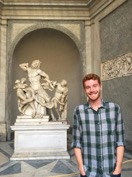
Sam Henthorn ’20 — While I was living in Rome this past semester, I had the extraordinary opportunity to visit a multitude of museums showcasing classical art. I was enrolled in an early Christian art class which focused on the emergence of the budding religion through visual representation.
In the classroom, the idea of a marble sculpture or a terracotta pot decorated with mythical scenes lacks a certain flash. The idea of sculpture may seem impressive in the theoretical, but to see an ancient masterpiece such as The Boxer at Restin person creates a completely new sense of awe.
Throughout my travels this past semester, I was fortunate enough to visit the Pergamum, Nives, and Altes Museums in Berlin, Germany along with the Vatican and British Museums. Between the five of these collections is a significant piece of all of the extant classical works open to the public, and perhaps the closest look into what life in eras past may have been like.
As I began to see pieces that I recognized (such as the Market Gates of Miletus), I was not only surprised by the monuments/sculptures themselves but also by my reaction. I always knew that these people, emperors, and palaces existed through writings and pictures, but looking at the same artwork that so many ancient peoples saw created a connection between me and them that text alone was not able to spark.
Because of this opportunity that the Givens family provided me, I was able to observe the progression from Classical Greek artwork all the way to the later Imperial period, which has only supplemented my education in a way that Wabash alone would never have been able to.